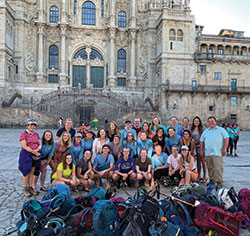‘Transformation,’ valuable life lessons highlight students’ curriculum on Camino pilgrimage in Spain

Camino pilgrims are all smiles after reaching their final destination: the Cathedral of St. James in northern Spain. (Submitted photo)
By Sara Geer (Special to The Criterion)
Jeremiah Gibbs has one goal as he leads a group of college students and professors on a 165-mile pilgrimage along the Camino de Santiago de Compostela to the Cathedral of St. James in northern Spain.
As a chaplain for the University of Indianapolis, Gibbs makes it known to each student that the reason for taking a spiritual pilgrimage is to change your life.
“Transformation is the goal of pilgrimage,” Gibbs said. “Sometimes the change is radical, and students change entire aspects of their life, while other times it is gradual and more subtle changes to the way they approach life.”
This was true for the students and faculty who walked the Camino—in English, “the way”—in May.
The 21-day trip brought together students from all walks of life—Catholics and people of other faith traditions, and those who were athletic with others who were non-athletic.
The journey also offered them the chance to bond with each other, engage in self-reflection and escape the everyday distractions from school, work and technology.
‘Every step I took, God was walking with me’
Along with Gibbs, professor Julie Gahimer of the University of Indianapolis’ Krannert School of Physical Therapy and a member of SS. Francis and Clare of Assisi Parish in Greenwood, helped lead the group. This was her second time walking the Camino, which pilgrims have followed for more than 1,000 years.
Both remarked there was a very strong Catholic student presence on the trip. Many students who completed the pilgrimage worshipped together at Mass and shared evening group prayer in many of the small villages along the trail, and Gahimer said even non-Catholics attended consistently.
“Many students on the pilgrimage were unfamiliar with the Catholic faith. They would attend Mass in many of the villages and were curious about Catholic faith traditions,” Gahimer said. “They asked many questions about why we Catholics do the things we do, and in particular wanted to know more about the rituals, prayers and the Eucharist.”
The Camino also had a profound impact on those who had seen a decline in their faith prior to the journey. Mary Pruett, a second-year nursing student and a member of St. Joseph-St. Raphael Parish in Springfield, Ohio, signed up for the pilgrimage with the hope that the silence while walking a long distance would reignite her faith.
“I was challenging God and asking him why I could not feel him as much anymore,” Pruett said. “While walking the Camino, I discovered he was right there with me. Every step I took, God was walking with me.
“I was able to get some deep prayer time with him during times of walking in silence,” she added.
Others, including Caroline Kavanaugh, a member of St. Roch Parish in Indianapolis and a member of the executive board of the university’s Catholic Student Association, grew more in love with their faith on the Camino. She took the time to reflect on the many relationships in her life while admiring the expansive mountainous scenery that filled most of the journey.
“On [the] Camino, you get to walk through God’s beautiful creation of nature, and you get to meet so many other people of faith,” Kavanaugh said. “God was with me every step, guiding me to Santiago [de Compostela]. Also, my friends and my family supported me the whole way.
“I knew they were thinking of me,” she continued, “and I got occasional motivational texts from my mom with ‘You’re almost there! Keep it up!’ ”
‘Buen Camino’
Annually, 250,000 pilgrims from all over the world walk the Camino. One of the most dynamic experiences during the pilgrimage is sharing the trail and building relationships with others who are not part of your group. A popular greeting shared among pilgrims is, “Buen Camino,” which translated means “good way” or “good walk.”
Pruett said when she met people from Australia and New Zealand, she would introduce herself and say she was a nursing major. The encouragement she received from complete strangers amazed her.
“So many individuals would, out of nowhere, encourage me,” Pruett said. “They would tell me ‘to keep going,’ not with my walking, but with life. They had no idea about my abilities but would proclaim that one day I would be an amazing nurse and do great things.”
Meeting others along the trail also provided much needed inspiration to complete the pilgrimage. Hillary Carnell, a member of Rosedale Hills United Methodist Church in Indianapolis, had surgery on her left knee in 2018 and was scheduled to have right knee surgery after the trip in June. She did not let it stop her from hiking the Camino.
“My Dad texted me, ‘feet heal, memories last forever,’ and that really stuck with me,” Carnell said. “The aches, pains and exhaustion of hiking is worth the other pilgrims you meet and getting closer to the other students on our trip.”
Once the group arrived at the Cathedral of St. James, they were able to reunite again with those they met along the way, worship at Mass and embrace each other with the accomplishment that they all completed the pilgrimage. Some students knew a few of their classmates before the trip, but by the end had made many best friends.
“I learned that I am not alone,” Carnell said. “On [the] Camino, everyone is there for each other. A pilgrim I met was hiking on her own. I pointed that out and she said, ‘Look around. I am not alone.’ ”
The next University of Indianapolis pilgrimage on the Camino is planned for the spring term of 2021.
(Sara Geer is a freelance writer and member of St. Louis de Montfort Parish in Fishers, Ind., in the Diocese of Lafayette.) †
